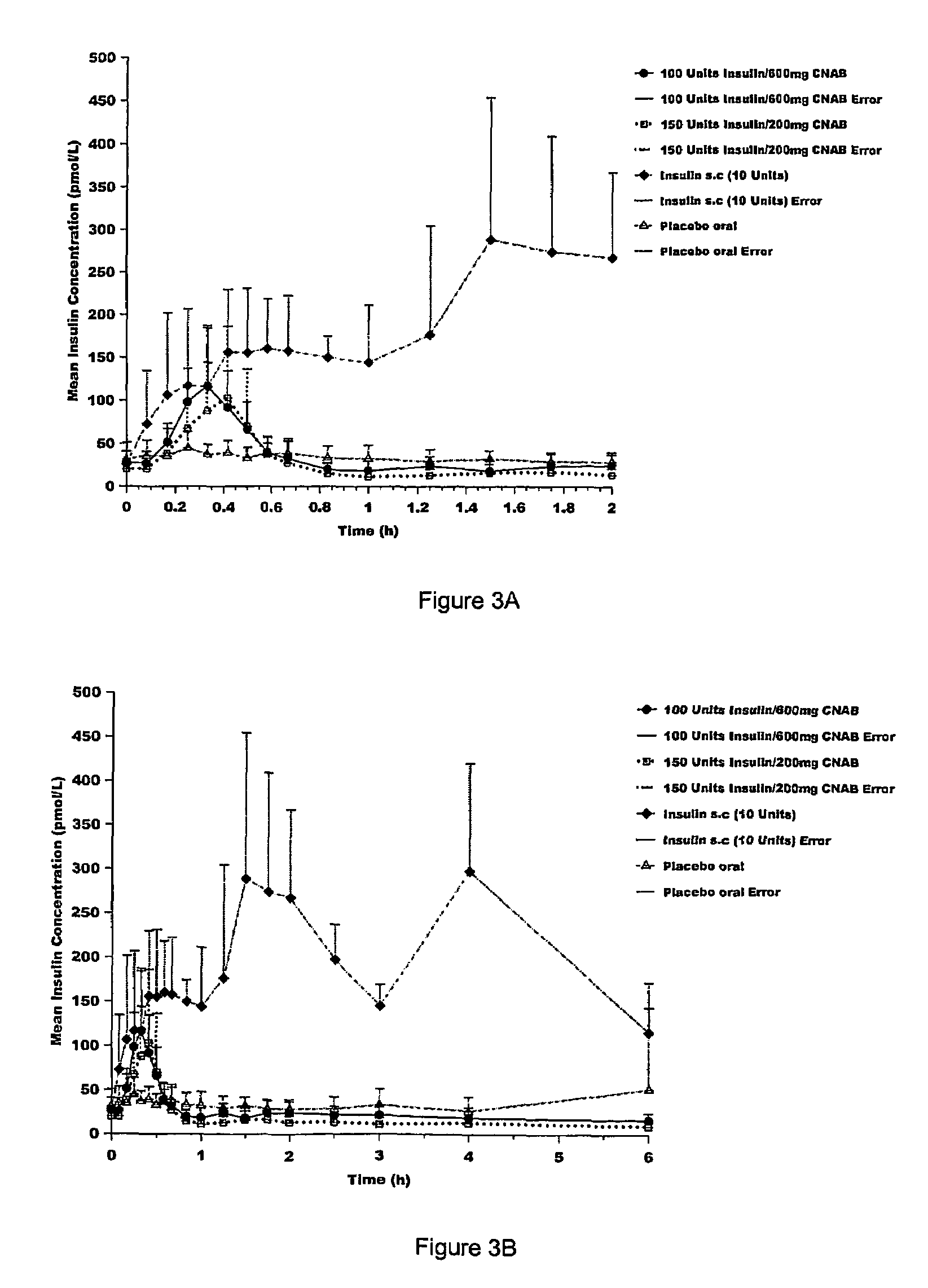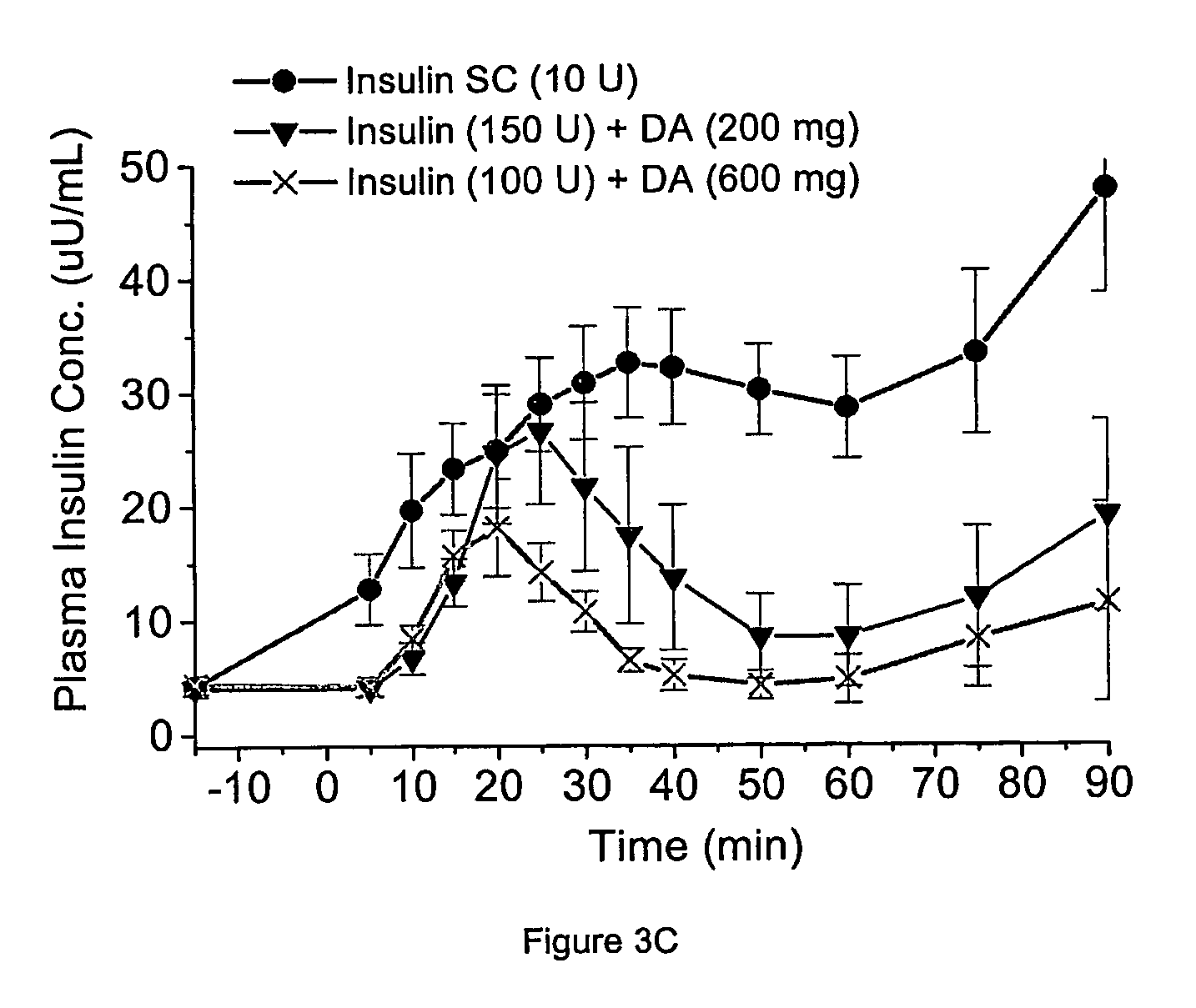Oral insulin therapy
a technology of oral insulin and insulin syringe, which is applied in the direction of drug compositions, peptides, metabolic disorders, etc., can solve the problems of morbidity in the population, many obstacles to successful oral delivery of biological macromolecules, and limited use of biological macromolecules as active agents in pharmaceutical compositions
- Summary
- Abstract
- Description
- Claims
- Application Information
AI Technical Summary
Benefits of technology
Problems solved by technology
Method used
Image
Examples
example 1
Plasma Delivery Agent Design and Efficiency
[0229]Delivery agents 1-3 were investigated for their ability to penetrate the GI mucosa. The plasma concentration of each delivery agent was measured in human subjects after oral administration of delivery agent loaded capsules as a measure of each delivery agent's penetration efficiency. See Tables 1 and 2.
[0230]
TABLE 1Structures of Delivery Agents 1-3Delivery Agent 1 (SNAC)Delivery Agent 2 (SNAD)Delivery Agent 3 (4-CNAB)
[0231]
TABLE 2Delivery Agent Plasma Concentrations in HumansVariablesDelivery AgentAUCDelivery AgentXnDose (Mg)(ng · hr / ml)1 (SNAC)H775034992 (SNAD)H975020373 (4-CNAB)Cl380047478
[0232]Blood sampling for plasma delivery agent concentration determination (2 mL in sodium heparin tube) were drawn 15 minutes before dosing, and at 5, 10, 15, 30, and 45 minutes and 1, 1.5, 2, 3, 4, 6, 8, and 12 hours post-dose (14 samples per treatment) for delivery agent measurements in all treatment groups.
[0233]Two 18-gauge IV lines were situa...
example 2
Comparison of the Delivery Efficiency of Delivery Agents 1-3
[0237]Next, delivery agents 1-3 were compared for the ability to efficiently transport an active agent across the GI mucosa in a biologically active form by determining the relationship between delivery agent dose, dose of active agent and the glucose response. See Table 4. The effective dose of delivery agent necessary to deliver a therapeutic dose of active agent and produce a therapeutic effect was measured. See Table 4. For delivery agent 3, the active agent was insulin, and the therapeutic effect was determined by the ability of the delivery agent / insulin combination to lower serum glucose by at least 10% within one hour post administration. For delivery agents 1 and 2, the active agent was heparin, and the therapeutic effect was determined by [Emisphere: please fill in]
[0238]
TABLE 4Effective Clinical Dose of Delivery Agent in HumansDelivery AgentDelivery AgentXNDose (Mg)1 (SNAC)H724002 (SNAD)H915003 (4-CNAB)Cl3200
[023...
example 3
Preparation of the Delivery Agent 4-CNAB
[0241]The compound corresponding to the following structure may be prepared as described below:
[0242]
[0243]4-Chlorosalicylic acid (10.0 g, 0.0579 mol) was added to a one-neck 250 ml round-bottomed flask containing about 50 ml methylene chloride. Stirring was begun and continued for the remainder of the reaction. The coupling agent 1,1-carbonyldiimidazole (9.39 g, 0.0579 mol) was added as a solid in portions to the flask. The reaction was stirred at room temperature for approximately 20 minutes after all of the coupling agent had been added and then ethyl-4-aminobutyrate hydrochloride (9.7 g, 0.0579 mol) was added to the flask with stirring. Next, triethylamine (10.49 ml, 0.0752 mol) was added dropwise from an addition funnel. The addition funnel was rinsed with methylene chloride. The reaction was allowed to stir at room temperature overnight.
[0244]The reaction was poured into a separatory funnel and washed with 2N HCl and an emulsion formed. ...
PUM
| Property | Measurement | Unit |
|---|---|---|
| concentration | aaaaa | aaaaa |
| concentration Cmax | aaaaa | aaaaa |
| total weight | aaaaa | aaaaa |
Abstract
Description
Claims
Application Information
 Login to View More
Login to View More - R&D
- Intellectual Property
- Life Sciences
- Materials
- Tech Scout
- Unparalleled Data Quality
- Higher Quality Content
- 60% Fewer Hallucinations
Browse by: Latest US Patents, China's latest patents, Technical Efficacy Thesaurus, Application Domain, Technology Topic, Popular Technical Reports.
© 2025 PatSnap. All rights reserved.Legal|Privacy policy|Modern Slavery Act Transparency Statement|Sitemap|About US| Contact US: help@patsnap.com



